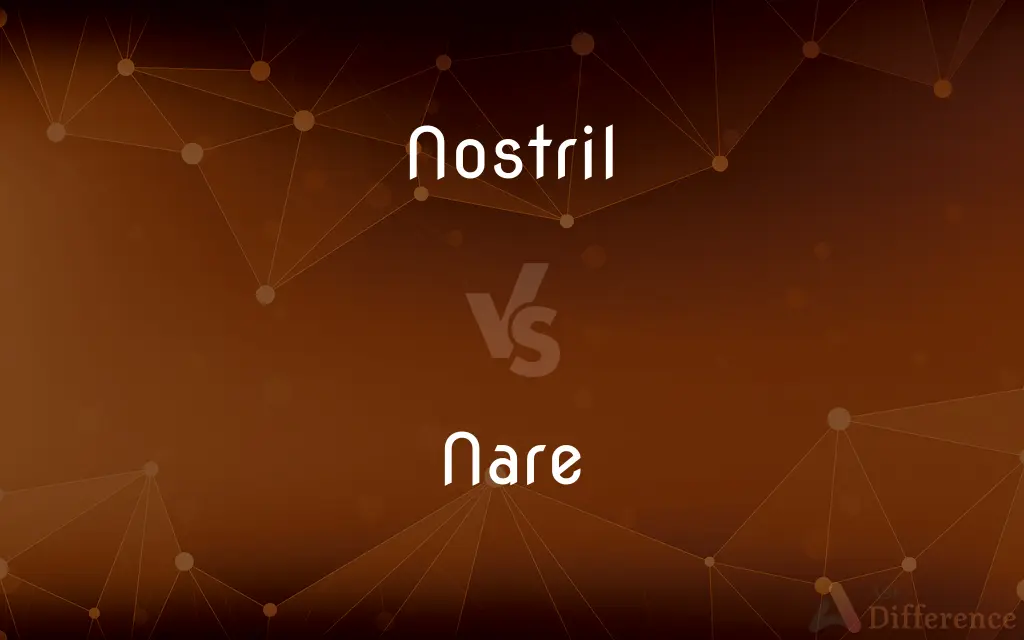Nostril vs. Nare — What's the Difference?
By Fiza Rafique & Maham Liaqat — Updated on February 29, 2024
A nostril is one of two external openings of nose in humans and many animals, serving as passageway for air. "Nare" is less commonly used term that specifically refers to either of the nostrils, particularly in zoology, emphasizing its scientific context.

Difference Between Nostril and Nare
Table of Contents
ADVERTISEMENT
Key Differences
Nostrils are critical components of the respiratory system, allowing for the inhalation of air into the lungs and the exhalation of carbon dioxide. They are also involved in the sense of smell, filtering, humidifying, and warming the air breathed in. "Nare," on the other hand, is a term more frequently encountered in scientific and zoological discussions. It specifically denotes the nostril of an animal, often used in the study of animal anatomy and physiology.
The term "nostril" is widely used in everyday language and applies to both humans and animals, highlighting its universality across different contexts. While "nare" can technically refer to human nostrils, its usage is particularly relevant in describing the nasal features of animals, offering a more technical perspective.
Both terms share the same basic function related to breathing and olfaction but differ in their usage context. "Nostril" is the more common term, suitable for general and medical discussions, whereas "nare" is preferred in scientific texts, especially those focusing on zoology or comparative anatomy.
The distinction between nostril and nare, therefore, lies not in their anatomical function but in the linguistic preference and context of use. While everyday conversations and medical contexts will almost exclusively use "nostril," scientific literature, especially in the field of zoology, may opt for "nare" to describe the same anatomical structure with a slight emphasis on its scientific relevance.
Comparison Chart
Definition
One of the two external openings of the nose.
Scientific term for a nostril, especially in animals.
ADVERTISEMENT
Usage Context
General and medical discussions.
Scientific and zoological discussions.
Function
Serves as a passageway for air, involved in breathing and smell.
Same as nostril, with specific emphasis in zoology.
Commonality
Widely used in everyday language.
Less commonly used, more technical.
Relevance
Humans and animals.
Primarily animals in scientific contexts.
Compare with Definitions
Nostril
A key part of the olfactory system.
Scents are detected when air passes through the nostrils.
Nare
Used in scientific descriptions.
This species has particularly large nares for better olfaction.
Nostril
Involved in the respiratory system.
Breathing through your nostrils can help filter and warm the air.
Nare
Zoological term for nostril.
The nare of a dolphin is located on top of its head.
Nostril
Subject to medical conditions.
He had surgery to correct a deviated septum affecting his nostril.
Nare
Specific to animal anatomy studies.
Researchers examined the nare structure to understand breathing patterns.
Nostril
An external opening of the nose.
She wore a small ring in her left nostril.
Nare
Appears in technical and scientific literature.
The study focused on nare functionality in amphibians.
Nostril
Can be adorned for cultural or aesthetic reasons.
Nostril piercings are popular in many cultures.
Nare
Relevant in comparative anatomy.
Comparing the nares of different species reveals evolutionary adaptations.
Nostril
A nostril (or naris , plural nares ) is one of the two channels of the nose, from the point where they bifurcate to the external opening. In birds and mammals, they contain branched bones or cartilages called turbinates, whose function is to warm air on inhalation and remove moisture on exhalation.
Nare
A nostril
Nostril
Either of the external openings of the nose; a naris.
Nostril
Either of the two orifices located on the nose (or on the beak of a bird); used as a passage for air and other gases to travel the nasal passages.
Nostril
Either one of the two external openings to the nasal cavity in the nose
Common Curiosities
What is the main function of a nostril/nare?
The main function is to facilitate breathing by allowing the passage of air into the respiratory system and to contribute to the sense of smell.
Can "nare" be used to refer to human nostrils?
Technically, yes, but its usage is more common in scientific contexts relating to animals.
Why might someone use "nare" instead of "nostril"?
"Nare" might be used for specificity in scientific or zoological discussions, emphasizing the study of animal anatomy.
Are there any structural differences between a nostril and a nare?
Structurally, they refer to the same thing; the difference lies in the usage context of the terms.
How do nostrils contribute to the sense of smell?
Nostrils draw air into the nasal cavity where olfactory receptors are located, capturing scent molecules which are then interpreted by the brain.
Is the term "nare" common in medical discussions?
No, "nostril" is predominantly used in medical contexts, with "nare" being reserved for scientific research or discussions focusing on animal anatomy.
Why is the study of nares important in zoology?
Studying nares helps scientists understand various aspects of animal life, including respiratory mechanisms, olfactory capabilities, and evolutionary adaptations.
How are nostrils maintained healthily?
Maintaining healthy nostrils involves regular cleaning, managing allergies, and avoiding irritants that can lead to congestion or respiratory issues.
Can alterations to the nostrils affect breathing?
Yes, structural or functional changes to the nostrils, such as from injury or medical conditions, can impact air passage and breathing efficiency.
How do animals with differently located nares, like dolphins, breathe?
Animals like dolphins have adapted their nare location (blowhole on top of the head) to facilitate breathing at the surface of the water without fully emerging.
Share Your Discovery

Previous Comparison
Meteoroid vs. Asteroid
Next Comparison
Appropriate vs. InappropriateAuthor Spotlight
Written by
Fiza RafiqueFiza Rafique is a skilled content writer at AskDifference.com, where she meticulously refines and enhances written pieces. Drawing from her vast editorial expertise, Fiza ensures clarity, accuracy, and precision in every article. Passionate about language, she continually seeks to elevate the quality of content for readers worldwide.
Co-written by
Maham Liaqat













































